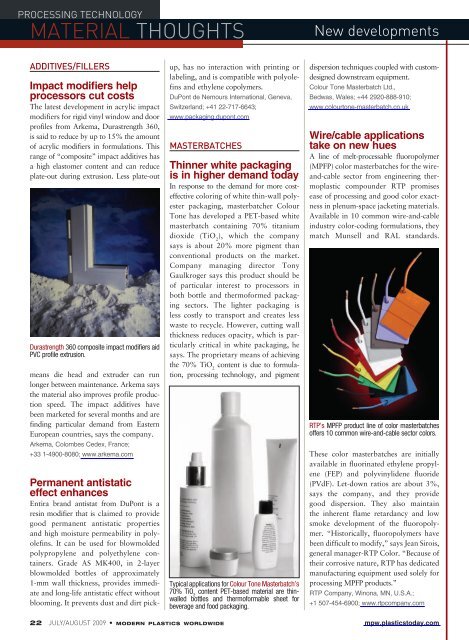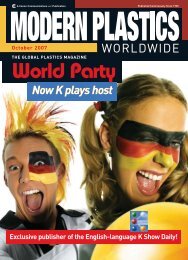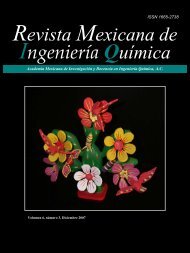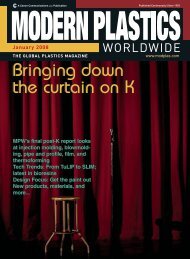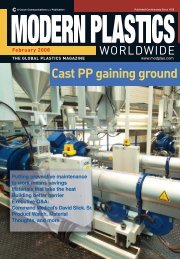Modern Plastics Worldwide - July/August 2009 - dae uptlax
Modern Plastics Worldwide - July/August 2009 - dae uptlax
Modern Plastics Worldwide - July/August 2009 - dae uptlax
You also want an ePaper? Increase the reach of your titles
YUMPU automatically turns print PDFs into web optimized ePapers that Google loves.
PROCESSING TECHNOLOGY<br />
MATERIAL THOUGHTS<br />
ADDITIVES/FILLERS<br />
Impact modifi ers help<br />
processors cut costs<br />
The latest development in acrylic impact<br />
modifiers for rigid vinyl window and door<br />
profiles from Arkema, Durastrength 360,<br />
is said to reduce by up to 15% the amount<br />
of acrylic modifiers in formulations. This<br />
range of “composite” impact additives has<br />
a high elastomer content and can reduce<br />
plate-out during extrusion. Less plate-out<br />
Durastrength 360 composite impact modifiers aid<br />
PVC profile extrusion.<br />
means die head and extruder can run<br />
longer between maintenance. Arkema says<br />
the material also improves profile production<br />
speed. The impact additives have<br />
been marketed for several months and are<br />
finding particular demand from Eastern<br />
European countries, says the company.<br />
Arkema, Colombes Cedex, France;<br />
+33 1-4900-8080; www.arkema.com<br />
Permanent antistatic<br />
effect enhances<br />
Entira brand antistat from DuPont is a<br />
resin modifier that is claimed to provide<br />
good permanent antistatic properties<br />
and high moisture permeability in polyolefins.<br />
It can be used for blowmolded<br />
polypropylene and polyethylene containers.<br />
Grade AS MK400, in 2-layer<br />
blowmolded bottles of approximately<br />
1-mm wall thickness, provides immediate<br />
and long-life antistatic effect without<br />
blooming. It prevents dust and dirt pick-<br />
up, has no interaction with printing or<br />
labeling, and is compatible with polyolefins<br />
and ethylene copolymers.<br />
DuPont de Nemours International, Geneva,<br />
Switzerland; +41 22-717-6643;<br />
www.packaging.dupont.com<br />
MASTERBATCHES<br />
Thinner white packaging<br />
is in higher demand today<br />
In response to the demand for more costeffective<br />
coloring of white thin-wall polyester<br />
packaging, masterbatcher Colour<br />
Tone has developed a PET-based white<br />
masterbatch containing 70% titanium<br />
dioxide (TiO 2 ), which the company<br />
says is about 20% more pigment than<br />
conventional products on the market.<br />
Company managing director Tony<br />
Gaulkroger says this product should be<br />
of particular interest to processors in<br />
both bottle and thermoformed packaging<br />
sectors. The lighter packaging is<br />
less costly to transport and creates less<br />
waste to recyc le. However, cutting wall<br />
thickness reduces opacity, which is particularly<br />
critical in white packaging, he<br />
says. The proprietary means of achieving<br />
the 70% TiO 2 content is due to formulation,<br />
processing technology, and pigment<br />
Typical applications for Colour Tone Masterbatch’s<br />
70% TiO 2 content PET-based material are thinwalled<br />
bottles and thermoformable sheet for<br />
beverage and food packaging.<br />
New developments<br />
dispersion techniques coupled with customdesigned<br />
downstream equipment.<br />
Colour Tone Masterbatch Ltd.,<br />
Bedwas, Wales; +44 2920-888-910;<br />
www.colourtone-masterbatch.co.uk<br />
Wire/cable applications<br />
take on new hues<br />
A line of melt-processable fluoropolymer<br />
(MPFP) color masterbatches for the wireand-cable<br />
sector from engineering thermoplastic<br />
compounder RTP promises<br />
ease of processing and good color exactness<br />
in plenum-space jacketing materials.<br />
Available in 10 common wire-and-cable<br />
industry color-coding formulations, they<br />
match Munsell and RAL standards.<br />
RTP’s MPFP product line of color masterbatches<br />
offers 10 common wire-and-cable sector colors.<br />
These color masterbatches are initially<br />
available in fluorinated ethylene propylene<br />
(FEP) and polyvinylidene fluoride<br />
(PVdF). Let-down ratios are about 3%,<br />
says the company, and they provide<br />
good dispersion. They also maintain<br />
the inherent flame retardancy and low<br />
smoke development of the fluoropolymer.<br />
“Historically, fluoropolymers have<br />
been difficult to modify,” says Jean Sirois,<br />
general manager-RTP Color. “Because of<br />
their corrosive nature, RTP has dedicated<br />
manufacturing equipment used solely for<br />
processing MPFP products.”<br />
RTP Company, Winona, MN, U.S.A.;<br />
+1 507-454-6900; www.rtpcompany.com<br />
22 JULY/AUGUST <strong>2009</strong> • MODERN PLASTICS WORLDWIDE mpw.plasticstoday.com


